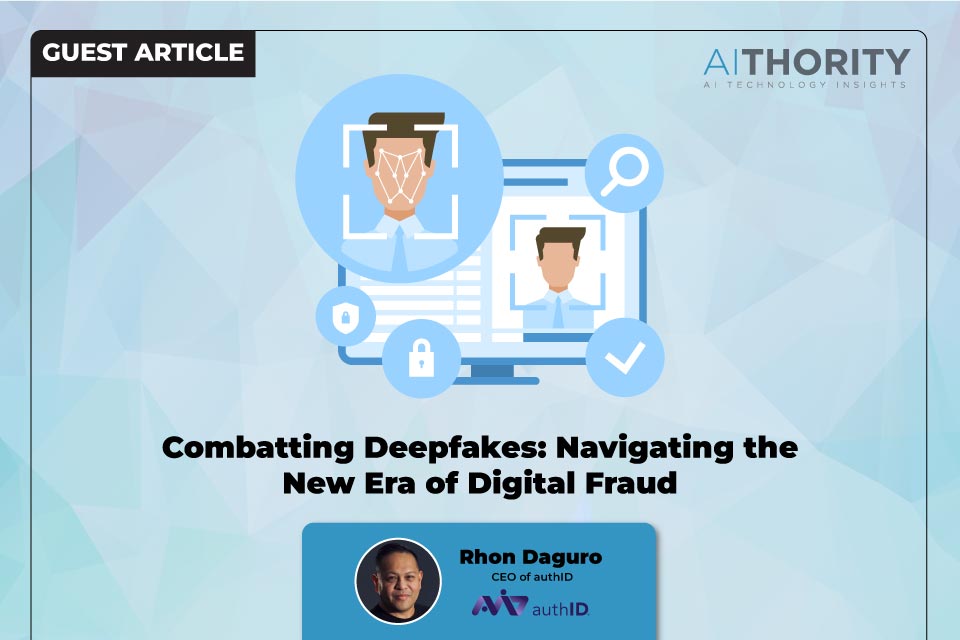The Rise of Deepfakes and the Need for Stronger Security Measures
In recent years, the rise of deepfake technology has sparked concern across multiple industries. As digital tools continue to advance, the line between reality and fabrication is becoming increasingly blurred. Deepfakes—realistic yet fake images, voices, and videos created by AI—are now being weaponized in ways that make traditional defenses outdated. From identity fraud to misinformation campaigns, the dangers are real and evolving rapidly.
A recent whitepaper by authID, “The Spread of Deepfakes and How to Protect Yourself Against Them,” explores the mechanics of deepfakes, their rapid proliferation, and the sophisticated fraud they enable. It discusses how deepfakes are created, why they pose such a significant threat, and the need for innovative defenses to keep pace with these developments, emphasizing the urgent necessity for stronger security measures in our increasingly digital world.
How Deepfakes Are Created and Perfected
Deepfakes are not just clever photo or video edits. They rely on advanced AI techniques like Generative Adversarial Networks (GANs), which use a dual-system process to create progressively realistic fake media. Artificial Neural Networks (ANNs) also play a critical role in this process by leveraging vast amounts of data to mimic human features, voices, and behaviors with accuracy.
This evolution in deepfake technology means that criminals no longer need expert-level knowledge to create fraudulent content. Accessible apps and platforms make it easy for anyone to generate deepfakes with little effort, ushering in a new wave of AI-driven fraud.
The Expanding Scope of Deepfake-Driven Fraud
As deepfake technology advances, so do the ways it’s used to perpetrate fraud. Criminals are deploying deepfakes to create fake identities, impersonate real individuals, and forge documents such as driver’s licenses or passports. These deepfake IDs are then used to open fraudulent accounts, access financial resources, or exploit systems reliant on identity verification.
A particularly concerning form is synthetic identity fraud, where criminals blend real and fabricated data to create entirely new identities. Unlike traditional identity theft—where a fraudster steals an existing person’s details—synthetic fraud involves constructing an identity from scratch. This can involve deepfake visuals that mimic real people or entirely invented individuals, allowing fraudsters to slip through standard verification checks with ease.
The Challenges of Detecting Deepfakes
The primary danger of deepfakes lies in their ability to fool both human and digital systems. As the technology improves, deepfakes become harder to detect. Traditional security measures like password-based logins or simple identity checks are inadequate against these evolving threats.
One common technique is the “presentation attack,” where a deepfake is presented directly to a camera or other sensor, which forwards it for authentication. If the system isn’t sophisticated enough to detect the fake, it gets processed as legitimate. Another method, known as an “injection attack,” bypasses the presentation process entirely. Fraudsters inject the fake into the data stream behind the camera, allowing it to reach the backend system undetected.
Deepfakes and the Human Element
Although deepfakes are a technological threat, their primary target remains human. Fraudsters rely on the manipulation of human trust to make their scams successful. From fake voices to phony IDs, deepfakes are used to trick individuals into believing they are interacting with a legitimate person or entity. This has significant implications for customer service, call centers, and even internal company operations.
The Power of Biometric Authentication in Combating Deepfakes
Traditional fraud detection and prevention methods are inadequate against deepfakes. While techniques like device-based authentication and multi-factor authentication offer some protection, deepfakes can bypass these defenses through clever manipulation of both human and machine-based authentication processes.
This is where biometric authentication becomes crucial. Unlike passwords or token-based systems, biometrics utilize unique physical and behavioral characteristics—such as facial features, fingerprints, and voice patterns—that are extremely difficult to replicate accurately, even with advanced deepfake technology. For instance, AI-powered liveness detection, a biometric capability, can distinguish between a real human face and a deepfake by analyzing subtle, involuntary movements like eye blinks or skin texture changes that deepfakes struggle to mimic. By verifying that the source is a live, present person rather than a manipulated image or video, biometric systems add a critical layer of defense.
Furthermore, biometric systems are adaptive and can be continually trained to recognize emerging deepfake patterns, ensuring they stay ahead of fraudsters. A multi-layered approach incorporating biometric authentication, AI-powered liveness detection, and other advanced tools provides the necessary security to stay ahead of deepfake fraudsters, allowing organizations to protect their systems and customers effectively.
Conclusion
Deepfakes are no longer a distant concern— they are a growing danger to individuals and organizations alike. As fraudsters continue to exploit AI to create more convincing deepfakes, businesses must evolve their security strategies to counter these threats. By understanding the mechanics of deepfakes and adopting cutting-edge solutions, companies can mitigate the risks and protect their digital assets in this increasingly complex landscape.
FAQs
Q: What are deepfakes, and how are they created?
A: Deepfakes are realistic yet fake images, voices, and videos created using advanced AI techniques like GANs and ANNs.
Q: Why are deepfakes a growing concern?
A: Deepfakes are increasingly used to perpetrate fraud, manipulate human trust, and deceive digital systems, making traditional security measures inadequate against these evolving threats.
Q: What is the primary danger of deepfakes?
A: The primary danger of deepfakes lies in their ability to fool both human and digital systems, making traditional security measures insufficient against these emerging threats.
Q: How can organizations protect themselves against deepfake fraud?
A: Organizations can protect themselves against deepfake fraud by adopting multi-layered approaches incorporating biometric authentication, AI-powered liveness detection, and other advanced tools to stay ahead of fraudsters and protect their systems and customers effectively.
Q: What is biometric authentication, and how does it combat deepfakes?
A: Biometric authentication utilizes unique physical and behavioral characteristics to verify the identity of an individual. AI-powered liveness detection can distinguish between real and manipulated biometric data, adding a critical layer of defense against deepfake attacks.









